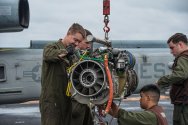honestly, this is too much technicality even i don't understood much. but 3D printing/laser tech with additive manufacturing they have been using heavily in high tech industries
Then it's worth going over. Casting is, at its most abstract, is taking a liquid and freezing it into a shape using a mold. The different terms "single crystal casting", "directional solidification" and just "casting" have to do with the atomic structure of the liquid after it freezes. Liquids typically solidify into crystals - a regular lattice of atoms.
When you just cool a liquid below its freezing point, crystals begin to form at different points in the liquid (called nucleation sites). Molecules or atoms from the liquid arrange themselves on the surface of the crystal and the crystal grows outward. Since there are many such crystals, they eventually push up against each other. The surfaces where crystals meet are called grain boundaries. The resulting solid is called "polycrystalline" (many crystals).
In almost every single application, this is nothing to worry about. But turbine blades are in a uniquely challenging environment - high temperature, high pressure, and high centrifugal forces. Grain boundaries in a turbine blade are weaknesses, and eventually the blades warps or cracks or otherwise fails.
With great difficultly, you can cool a liquid so that only one crystal forms and grows. All of the atoms of the liquid attach to that growing crystal and no other forms. This is single crystal casting, and it's what China had so much difficulty with in the past.
A step between just freezing the liquid haphazardly and single crystal casting is directional solidification. This is where multiple crystals form, but they all grow in the same direction parallel to each other. The resulting solid has grain boundaries and they're still weaknesses, but they're less weak than if the crystals grew in a disordered fashion.
All of this is to say
@latenlazy gave some explanation about ''3D printed Nickel based superalloy''
He's talking about something different. What he's referring to are macroscopic defects in the solid. Typically, in 3D printing bubbles and other large defects form in the solid because the melting and cooling from the laser pulses are so rapid that they trap gas. This is what BLT managed to control in their process and the resulting structure is free from such defects.
What I'm asking is if the 3D printed solid has multiple crystals. Grain boundaries aren't macroscopic defects, they're defects at the atomic level. To print a single crystal is far, far harder than printing a polycrystal structure free from cracks or bubbles.















